Opinion & Analysis
The data behind Keegan Bradley’s coaching change
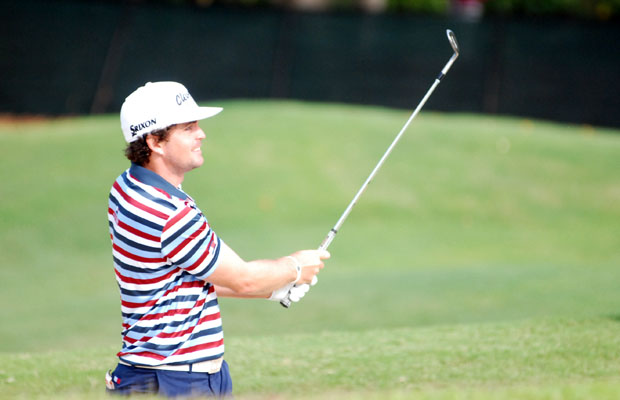
Keegan Bradley has reportedly left long-time swing coach Jim McLean for Chuck Cook, who teaches Bradley’s good friend Jason Dufner and Luke Donald. That gives Cook one of the most formidable list of clients in the golf world, as Bradley is ranked No. 20 in the Official World Golf Rankings, Dufner is ranked No. 15 and Donald is ranked No. 17.
I wanted to take a look at the numbers behind Bradley’s game and to see why he may have decided to change instructors. According to Bradley, the change was prompted by his familiarily with the instructor.
“I’ve been around Chuck Cook for a few years now, playing practice rounds with Dufner,” Bradley told Back9Network’s Ahmad Rashad. “I’m excited to get working with Chuck and get another opinion of how he thinks I can improve my golf game. He’s been around for a long time and I know he has several ways he can help me win.”
Bradley did not record a victory last season, but still finished No. 11 on the money list. When I look at a golfer’s game, I like to first analyze his or her scoring data. This helps me formulate some sort of idea of as to what went on with the golfer and provide a profile of the player’s game as far as his or her strengths and weaknesses go.
Bradley ranked No. 10 in Total Adjusted Scoring Average. Taking that into account and his rankings in the metrics in the table above, he still had a great season despite not coming away with a victory. I feel with these metrics that Bradley should be striving toward being the No. 1-ranked golfer in the world. He does not have a glaring weakness, and is instead trying to take his great game to the next level.
If Bradley is going to contend for the No. 1 spot, he will need to get inside the top 10 in Adjusted Par-4 Scoring Average. Par-4 play has the strongest correlation to Tour success of the metrics listed above. This is partially due to the number of par-4’s played per round (the Tour average is roughly 11 played per round), and the par-4’s require a more complete game to play them well. Bradley did a fine job in 2013 on the par-4’s. However, in order to contend for the No. 1 ranking in the world that will have to step up.
The biggest “weakness” we see with Bradley’s game is his play on the par-3’s. While par-3 play is important, it has the lowest correlation to success on Tour of the metrics listed. With that said, par-3 play is one part iron play, one part short game and one part long putting (putts longer than 15 feet). While Bradley was still an above-average player on the par-3’s, given that it was his weakest metric, I can start to develop an idea of what some of his issues in 2013 were.
Lastly, he had a fantastic year at avoiding bogies. Avoiding bogies has a stronger correlation to success on Tour than making birdies. He also made a high percentage of birdies. But, for him to contend for the No. 1 ranking in the world, he needs to get into the top 10 in both Birdie and Bogey rates. Furthermore, I find it a bit peculiar that the No. 1-ranked player on par-5’s ranked 24th in Birdie Rate. In all, I can start to envision a profile for Bradley’s game.
DRIVING DATA
I utilize an algorithm based on historical driving data on Tour dating back to 2007 to determine a golfer’s effectiveness off the tee. This is called Driving Effectiveness which utilizes the following metrics:
- Distance
- Fairway Percentage
- Average Distance to Edge of Fairway (on drives that miss the fairway)
- Fairway Bunker Percent
- Missed Fairway – Other Percent (shots that end up in a hazard, O.B. rescue shots, etc)
Here is Bradley’s data for 2013
As we can see, driving was rarely a problem for Bradley in 2013, as he was the second most effective driver of the ball (only Henrik Stenson was more effective). Bradley hits the ball a long way and hits a lot of fairways. And when he missed the fairway, he did not miss by much and did a fine job at avoiding fairway bunkers and other trouble. He has been one of the premier drivers on Tour since he earned his card.
PUTTING AND SHORT GAME DATA
Often times, putting and short game play can be over-valued by golfers. However, nothing can prevent a golfer from winning a tournament like poor putting. In fact, nearly 70 percent of the winners on Tour this year finished in the top 10 in Putts Gained (also called Strokes Gained-Putting) for that tournament.
Bradley putted very well in 2013 from most distances. As I have mentioned in the past, the putts from 3-to-15 feet are the most important putts to make when it comes to affecting a player’s performance versus the field. Outside of 15 feet, the make percentage for Tour players becomes very volatile. What I mean is that golfers on Tour, regardless of overall putting skill, tend to be very inconsistent when it comes to make percentage outside of 15 feet. One year they can make a lot of putts from outside 15 feet, and the next year they struggle to make those same putts.
This would explain some of the issues that Bradley had on the par-3’s. Tour players are not likely to have a lot of close birdie putts on the par-3’s, and that is why par-3 performance is dependent on the golfer’s ability to make putts outside of 15 feet. However, Bradley’s make percentage on putts outside of 15 feet is likely to progress toward the mean. Therefore, his performance on the par-3’s is likely to progress in 2014.
Sometimes the problem with good overall putters on Tour is that they were inconsistent with their putting. When they were off, they were well off. And when they were on, they were making a lot of putts. And if they putt poorly in too many tournaments, they reduce their odds of winning those events. Here’s a chart looking at Bradley’s putts gained by event.
Out of the 20 events that recorded putts gained, Bradley was only losing strokes to the field on six of those events.
Here is a look at Bradley’s short game play:
Bradley was an average short game player in 2013. But he did perform well from the most important part of the short game, longer pitch shots from 10-to-20 yards. This could also explain why he was better at avoiding bogies than making birdies. The 10-to-20 yard shots are usually more reserved for when the player needs to save par. The 1-to-10 yard shots are more makeable chip shots.
After looking at the data I see no reason why Bradley cannot contend for the No.1 spot in the world ranking based off his driving, putting and short game data. This only leaves approach shots.
APPROACH SHOT DATA
Here is Bradley’s approach shot data for 2013:
The good news is that the area that correlates strongest to success on Tour, the Danger Zone, is where Bradley was his strongest. Shorter shots, particular wedge play, are vastly overrated by the golfing community. This is why Bradley still had a fantastic year. His long game, both driving and Danger Zone play, was superb. This is where a golfer can gain the most strokes against the field over time.
Here’s a look at Bradley’s rankings from the various zones since he made the Tour:
We can see that Bradley has had issues with his iron play since he has made the Tour. His play from the Danger Zone has improved dramatically, and that has helped propel him into superstar status. But the play from the Birdie and Safe zones is what is holding him back. We also have to remember that his Safe Zone play is even worse than the ranking indicates because he was such an exceptional driver of the ball, which means he should have been in great position to hit a lot of Safe Zone shots closer to the hole.
His struggles from 75 to 175 yards would be part of the reason why he lagged a little behind on the par-3’s. It would also explain why his Birdie Rate was not better, as most birdies on the par-4’s come from Safe Zone and Birdie Zone approach shots.
All of these “issues” are nice issues for a player to have. I would expect that most of Bradley’s work with Cook will focus on improving his iron play from inside 175 yards. The key for him to take his game to the next level will be keeping his effectiveness off the tee and his skill on and around the greens while improving his iron play.
- LIKE1
- LEGIT0
- WOW0
- LOL0
- IDHT0
- FLOP0
- OB0
- SHANK0
19th Hole
Vincenzi’s 2024 Zurich Classic of New Orleans betting preview

The PGA TOUR heads to New Orleans to play the 2023 Zurich Classic of New Orleans. In a welcome change from the usual stroke play, the Zurich Classic is a team event. On Thursday and Saturday, the teams play best ball, and on Friday and Sunday the teams play alternate shot.
TPC Louisiana is a par 72 that measures 7,425 yards. The course features some short par 4s and plenty of water and bunkers, which makes for a lot of exciting risk/reward scenarios for competitors. Pete Dye designed the course in 2004 specifically for the Zurich Classic, although the event didn’t make its debut until 2007 because of Hurricane Katrina.
Coming off of the Masters and a signature event in consecutive weeks, the field this week is a step down, and understandably so. Many of the world’s top players will be using this time to rest after a busy stretch.
However, there are some interesting teams this season with some stars making surprise appearances in the team event. Some notable teams include Patrick Cantlay and Xander Schauffele, Rory McIlroy and Shane Lowry, Collin Morikawa and Kurt Kitayama, Will Zalatoris and Sahith Theegala as well as a few Canadian teams, Nick Taylor and Adam Hadwin and Taylor Pendrith and Corey Conners.
Past Winners at TPC Louisiana
- 2023: Riley/Hardy (-30)
- 2022: Cantlay/Schauffele (-29)
- 2021: Leishman/Smith (-20)
- 2019: Palmer/Rahm (-26)
- 2018: Horschel/Piercy (-22)
- 2017: Blixt/Smith (-27)
2024 Zurich Classic of New Orleans Picks
Tom Hoge/Maverick McNealy +2500 (DraftKings)
Tom Hoge is coming off of a solid T18 finish at the RBC Heritage and finished T13 at last year’s Zurich Classic alongside Harris English.
This season, Hoge is having one of his best years on Tour in terms of Strokes Gained: Approach. In his last 24 rounds, the only player to top him on the category is Scottie Scheffler. Hoge has been solid on Pete Dye designs, ranking 28th in the field over his past 36 rounds.
McNealy is also having a solid season. He’s finished T6 at the Waste Management Phoenix Open and T9 at the PLAYERS Championship. He recently started working with world renowned swing coach, Butch Harmon, and its seemingly paid dividends in 2024.
Keith Mitchell/Joel Dahmen +4000 (DraftKings)
Keith Mitchell is having a fantastic season, finishing in the top-20 of five of his past seven starts on Tour. Most recently, Mitchell finished T14 at the Valero Texas Open and gained a whopping 6.0 strokes off the tee. He finished 6th at last year’s Zurich Classic.
Joel Dahmen is having a resurgent year and has been dialed in with his irons. He also has a T11 finish at the PLAYERS Championship at TPC Sawgrass which is another Pete Dye track. With Mitchell’s length and Dahmen’s ability to put it close with his short irons, the Mitchell/Dahmen combination will be dangerous this week.
Taylor Moore/Matt NeSmith +6500 (DraftKings)
Taylor Moore has quickly developed into one of the more consistent players on Tour. He’s finished in the top-20 in three of his past four starts, including a very impressive showing at The Masters, finishing T20. He’s also finished T4 at this event in consecutive seasons alongside Matt NeSmith.
NeSmith isn’t having a great 2024, but has seemed to elevate his game in this format. He finished T26 at Pete Dye’s TPC Sawgrass, which gives the 30-year-old something to build off of. NeSmith is also a great putter on Bermudagrass, which could help elevate Moore’s ball striking prowess.
- LIKE7
- LEGIT3
- WOW1
- LOL1
- IDHT0
- FLOP3
- OB1
- SHANK1
19th Hole
Vincenzi’s 2024 LIV Adelaide betting preview: Cam Smith ready for big week down under

After having four of the top twelve players on the leaderboard at The Masters, LIV Golf is set for their fifth event of the season: LIV Adelaide.
For both LIV fans and golf fans in Australia, LIV Adelaide is one of the most anticipated events of the year. With 35,000 people expected to attend each day of the tournament, the Grange Golf Club will be crawling with fans who are passionate about the sport of golf. The 12th hole, better known as “the watering hole”, is sure to have the rowdiest of the fans cheering after a long day of drinking some Leishman Lager.
The Grange Golf Club is a par-72 that measures 6,946 yards. The course features minimal resistance, as golfers went extremely low last season. In 2023, Talor Gooch shot consecutive rounds of 62 on Thursday and Friday, giving himself a gigantic cushion heading into championship Sunday. Things got tight for a while, but in the end, the Oklahoma State product was able to hold off The Crushers’ Anirban Lahiri for a three-shot victory.
The Four Aces won the team competition with the Range Goats finishing second.
*All Images Courtesy of LIV Golf*
Past Winners at LIV Adelaide
- 2023: Talor Gooch (-19)
Stat Leaders Through LIV Miami
Green in Regulation
- Richard Bland
- Jon Rahm
- Paul Casey
Fairways Hit
- Abraham Ancer
- Graeme McDowell
- Henrik Stenson
Driving Distance
- Bryson DeChambeau
- Joaquin Niemann
- Dean Burmester
Putting
- Cameron Smith
- Louis Oosthuizen
- Matt Jones
2024 LIV Adelaide Picks
Cameron Smith +1400 (DraftKings)
When I pulled up the odds for LIV Adelaide, I was more than a little surprised to see multiple golfers listed ahead of Cameron Smith on the betting board. A few starts ago, Cam finished runner-up at LIV Hong Kong, which is a golf course that absolutely suits his eye. Augusta National in another course that Smith could roll out of bed and finish in the top-ten at, and he did so two weeks ago at The Masters, finishing T6.
At Augusta, he gained strokes on the field on approach, off the tee (slightly), and of course, around the green and putting. Smith able to get in the mix at a major championship despite coming into the week feeling under the weather tells me that his game is once again rounding into form.
The Grange Golf Club is another course that undoubtedly suits the Australian. Smith is obviously incredibly comfortable playing in front of the Aussie faithful and has won three Australian PGA Championship’s. The course is very short and will allow Smith to play conservative off the tee, mitigating his most glaring weakness. With birdies available all over the golf course, there’s a chance the event turns into a putting contest, and there’s no one on the planet I’d rather have in one of those than Cam Smith.

Louis Oosthuizen +2200 (DraftKings)
Louis Oosthuizen has simply been one of the best players on LIV in the 2024 seas0n. The South African has finished in the top-10 on the LIV leaderboard in three of his five starts, with his best coming in Jeddah, where he finished T2. Perhaps more impressively, Oosthuizen finished T7 at LIV Miami, which took place at Doral’s “Blue Monster”, an absolutely massive golf course. Given that Louis is on the shorter side in terms of distance off the tee, his ability to play well in Miami shows how dialed he is with the irons this season.
In addition to the LIV finishes, Oosthuizen won back-to-back starts on the DP World Tour in December at the Alfred Dunhill Championship and the Mauritus Open. He also finished runner-up at the end of February in the International Series Oman. The 41-year-old has been one of the most consistent performers of 2024, regardless of tour.
For the season, Louis ranks 4th on LIV in birdies made, T9 in fairways hit and first in putting. He ranks 32nd in driving distance, but that won’t be an issue at this short course. Last season, he finished T11 at the event, but was in decent position going into the final round but fell back after shooting 70 while the rest of the field went low. This season, Oosthuizen comes into the event in peak form, and the course should be a perfect fit for his smooth swing and hot putter this week.

- LIKE12
- LEGIT3
- WOW1
- LOL1
- IDHT0
- FLOP1
- OB1
- SHANK1
Opinion & Analysis
The Wedge Guy: What really makes a wedge work? Part 1

Of all the clubs in our bags, wedges are almost always the simplest in construction and, therefore, the easiest to analyze what might make one work differently from another if you know what to look for.
Wedges are a lot less mysterious than drivers, of course, as the major brands are working with a lot of “pixie dust” inside these modern marvels. That’s carrying over more to irons now, with so many new models featuring internal multi-material technologies, and almost all of them having a “badge” or insert in the back to allow more complex graphics while hiding the actual distribution of mass.
But when it comes to wedges, most on the market today are still single pieces of molded steel, either cast or forged into that shape. So, if you look closely at where the mass is distributed, it’s pretty clear how that wedge is going to perform.
To start, because of their wider soles, the majority of the mass of almost any wedge is along the bottom third of the clubhead. So, the best wedge shots are always those hit between the 2nd and 5th grooves so that more mass is directly behind that impact. Elite tour professionals practice incessantly to learn to do that consistently, wearing out a spot about the size of a penny right there. If impact moves higher than that, the face is dramatically thinner, so smash factor is compromised significantly, which reduces the overall distance the ball will fly.
Every one of us, tour players included, knows that maddening shot that we feel a bit high on the face and it doesn’t go anywhere, it’s not your fault.
If your wedges show a wear pattern the size of a silver dollar, and centered above the 3rd or 4th groove, you are not getting anywhere near the same performance from shot to shot. Robot testing proves impact even two to three grooves higher in the face can cause distance loss of up to 35 to 55 feet with modern ‘tour design’ wedges.
In addition, as impact moves above the center of mass, the golf club principle of gear effect causes the ball to fly higher with less spin. Think of modern drivers for a minute. The “holy grail” of driving is high launch and low spin, and the driver engineers are pulling out all stops to get the mass as low in the clubhead as possible to optimize this combination.
Where is all the mass in your wedges? Low. So, disregarding the higher lofts, wedges “want” to launch the ball high with low spin – exactly the opposite of what good wedge play requires penetrating ball flight with high spin.
While almost all major brand wedges have begun putting a tiny bit more thickness in the top portion of the clubhead, conventional and modern ‘tour design’ wedges perform pretty much like they always have. Elite players learn to hit those crisp, spinny penetrating wedge shots by spending lots of practice time learning to consistently make contact low in the face.
So, what about grooves and face texture?
Grooves on any club can only do so much, and no one has any material advantage here. The USGA tightly defines what we manufacturers can do with grooves and face texture, and modern manufacturing techniques allow all of us to push those limits ever closer. And we all do. End of story.
Then there’s the topic of bounce and grinds, the most complex and confusing part of the wedge formula. Many top brands offer a complex array of sole configurations, all of them admittedly specialized to a particular kind of lie or turf conditions, and/or a particular divot pattern.
But if you don’t play the same turf all the time, and make the same size divot on every swing, how would you ever figure this out?
The only way is to take any wedge you are considering and play it a few rounds, hitting all the shots you face and observing the results. There’s simply no other way.
So, hopefully this will inspire a lively conversation in our comments section, and I’ll chime in to answer any questions you might have.
And next week, I’ll dive into the rest of the wedge formula. Yes, shafts, grips and specifications are essential, too.
- LIKE32
- LEGIT7
- WOW1
- LOL1
- IDHT2
- FLOP3
- OB1
- SHANK3
-

 19th Hole2 weeks ago
19th Hole2 weeks agoDave Portnoy places monstrous outright bet for the 2024 Masters
-

 19th Hole2 weeks ago
19th Hole2 weeks agoTiger Woods arrives at 2024 Masters equipped with a putter that may surprise you
-

 19th Hole2 days ago
19th Hole2 days agoJustin Thomas on the equipment choice of Scottie Scheffler that he thinks is ‘weird’
-

 19th Hole2 days ago
19th Hole2 days ago‘Absolutely crazy’ – Major champ lays into Patrick Cantlay over his decision on final hole of RBC Heritage
-

 19th Hole3 weeks ago
19th Hole3 weeks agoReport: Tiger Woods has ‘eliminated sex’ in preparation for the 2024 Masters
-

 19th Hole1 week ago
19th Hole1 week agoTwo star names reportedly blanked Jon Rahm all week at the Masters
-

 19th Hole1 week ago
19th Hole1 week agoReport: LIV Golf identifies latest star name they hope to sign to breakaway tour
-

 19th Hole1 week ago
19th Hole1 week agoNeal Shipley presser ends in awkward fashion after reporter claims Tiger handed him note on 8th fairway

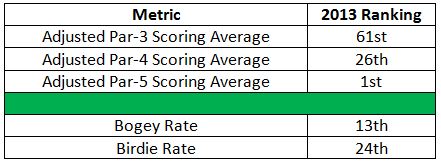
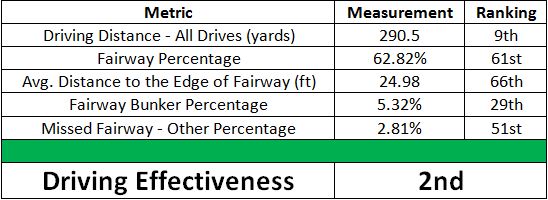

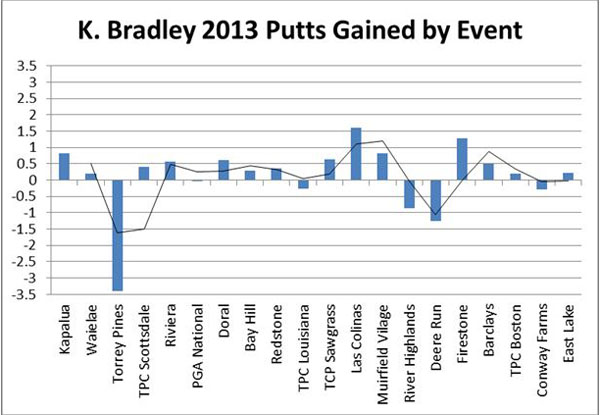















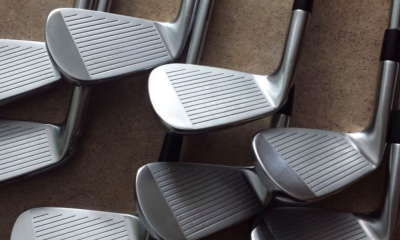













LY
Jan 1, 2014 at 12:12 pm
Rich:
What a great article! Do you do stat work with the LPGA tour and if so how do their numbers compare to the PGA tour?
LiveWire
Dec 30, 2013 at 5:28 pm
Great Data, I hope KB does better in 2014. I think he does a great job on the course. He has staying power for years to come. Hopefully he’ll win again before the Bo Sox do……
bsoudi
Dec 30, 2013 at 2:59 pm
Interesting analysis. Though it triggers 2 thoughts with me:
1) How important is the “standard deviation” of these stats? I guess I picture that as his consistency.
2) Could insight be gleaned from a comparison of all these attributes – say, could you see that on a great day driving, a player’s putting could be crap, etc.? That way players can get insights to get “all the pieces in place” more often?
Jadon
Dec 30, 2013 at 10:43 am
Wow, very interesting read. I’d like to see the same stats on Zach Johnson, a guy who is on the opposite end of the spectrum; doesn’t hit it a mile but relies on his wedges and short irons to “score” and get the job done. Goes to show you that you don’t have to be a bomber to succeed, what an odd and fun game we play.
Richie Hunt
Dec 30, 2013 at 11:11 am
Jadon, you would be shocked at how Zach got it done this year. He doesn’t hit it long, but his long approach shots (Danger Zone) is where he hit it the best from.
Mark Wells
Dec 30, 2013 at 1:57 am
Wonder why he feels he can’t work on the birdie and safe zone improvement with McClean? Solid and showing improvement otherwise. Time will tell
naflack
Dec 29, 2013 at 10:37 pm
i can see that little move off the ball that keegan does with his head being an issue on those short iron shots. im guessing chuck will want to address that…
Troy Vayanos
Dec 29, 2013 at 5:04 pm
Great post Rich,
Just shows how tough the tour is these days when a guy like Keegan can produce such impressive stats and still not come away with a victory.
Cheers
Richie Hunt
Dec 30, 2013 at 11:12 am
The bigger one is to look at Bo Van Pelt’s metrics from 2012. Outstanding ballstriker and was 11th in Putts Gained. Didn’t record 1 win. I almost found that impossible, but any given week somebody can sneak in and take it away from him.
Juan
Dec 29, 2013 at 12:11 pm
Rich, I really appreciate the great work you do with statistics!! It helps me understand the players you analyze AND a way of thinking about analyzing and improving my own game. BTW, I really like your website. THANKS again for the great work!!
Mike
Dec 29, 2013 at 11:26 am
Rich, great work. I love seeing data like this and a good thorough analysis. I look forward to reading more of your work.
Martin
Dec 29, 2013 at 9:45 am
Cool analysis, I also wonder what will happen when he switches putters.
I played with the same putter Keegan uses and gave it up because it wasn’t good enough on long putts to make up for the bit better it was on short ones. The stats seem to make the same case for Keegan.
Rob
Dec 29, 2013 at 8:16 am
Rich, interesting article, well done. I’m curious if anyone has studied “feel players” that use statistics heavily to engineer changes and what the results have been.
Rich
Dec 30, 2013 at 3:53 am
Could you really classify them as a true feel player if they looked at stats?
Rich
Dec 29, 2013 at 7:34 am
Yes I’m sure Keegan Bradley took all this into consideration when he decided to switch coaches. Actually, perhaps he’s not aware. You should drop him a line to let him know……..
Pingback: Desde el tee: semana 52/2013 | colombiaDeportes.co
Kenny Thomson
Dec 29, 2013 at 5:28 am
Another good article. How does an amateur collect such data without slowing up play? Enjoyed the book.
Kenny Thomson
Dec 29, 2013 at 5:26 am
Good article, but how does an amateur ( reasonably low handicap) capture similar data without slowing up play?
Enjoyed your book
Id
Dec 29, 2013 at 2:55 am
No glaring weakness??? What’s he going to do when he has to quit the belly putter?
Trey Hayden
Dec 29, 2013 at 5:02 am
It’s impossible to predict the future, but Bradley did win most of his college tournaments with a short putter. He switched for the same reason most guys in his generation switched: If they’re gonna let us cheat, we shall cheat.
Rob
Dec 29, 2013 at 8:05 am
You should understand the rules before making stupid comments, He doesn’t have to “quit the belly putter”
Id
Dec 29, 2013 at 10:35 am
He has to quit anchoring into the belly, therefore he has to quit that stroke. He can keep the same length putter, for sure, and use it un-anchored, therefore not calling it a non-belly putter but a putter at 43 inches or whatever – but he has to quit the belly putter. You should understand the comments before trying to sound intelligent.
Richie Hunt
Dec 30, 2013 at 11:14 am
I think I didn’t clarify what I meant by ‘glaring weakness’ anyway. What I meant is when you look at his *scoring* data (par-3’s, par-4’s, par-5’s, bogey rate and birdie rate) there was no glaring weakness there. Obviously he has a glaring weakness in his game…shots from inside 175 yards. As far as the putter goes, we will wait and see how that pans outs.
Sean
Dec 28, 2013 at 9:22 pm
Nice analysis. That right there should tell KB what he needs to work on.
Tom Stickney
Dec 28, 2013 at 7:04 pm
Great analysis Rich. Big fan of your work!
A
Dec 28, 2013 at 5:59 pm
I knew he was an idiot the moment I saw him
Homer Simpson
Dec 28, 2013 at 4:23 pm
“Facts are stubborn things, but statistics are more pliable.”
? Mark Twain
Roger
Dec 28, 2013 at 1:35 pm
Rich, thanks for another Great Article.
I see Luke Donald also moved to Chuck Cook due to his wish to
hit more par 4’s . Did a search of online videos of Chuck Cook
so thanks for the Xmas Present! I’m still young enough to Listen!
From 185 to the Pin is my problem area!
Have a great 2013 Rich.
Richie Hunt
Dec 28, 2013 at 8:46 pm
Thanks for the kind words